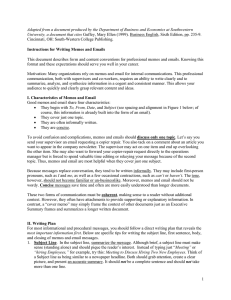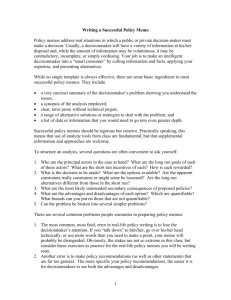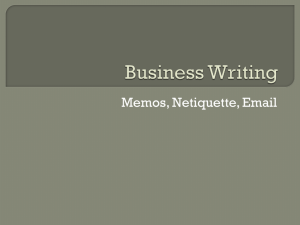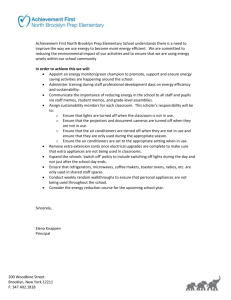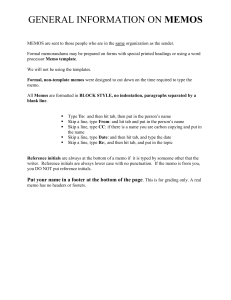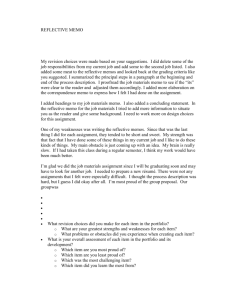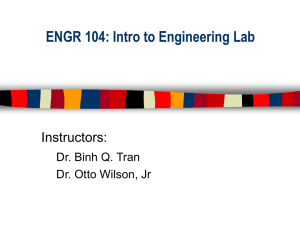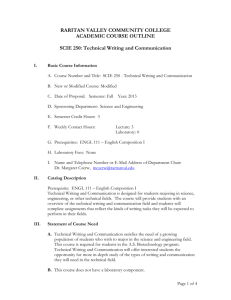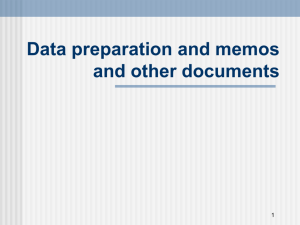Memos and E-mail Messages
advertisement
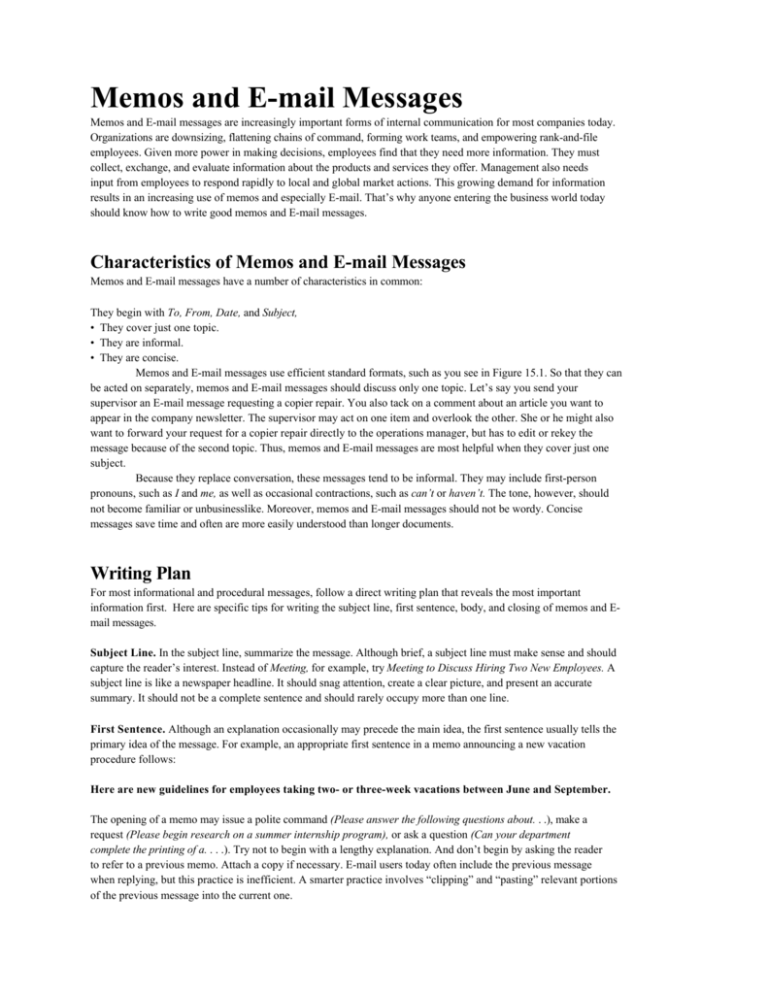
Memos and E-mail Messages Memos and E-mail messages are increasingly important forms of internal communication for most companies today. Organizations are downsizing, flattening chains of command, forming work teams, and empowering rank-and-file employees. Given more power in making decisions, employees find that they need more information. They must collect, exchange, and evaluate information about the products and services they offer. Management also needs input from employees to respond rapidly to local and global market actions. This growing demand for information results in an increasing use of memos and especially E-mail. That’s why anyone entering the business world today should know how to write good memos and E-mail messages. Characteristics of Memos and E-mail Messages Memos and E-mail messages have a number of characteristics in common: They begin with To, From, Date, and Subject, • They cover just one topic. • They are informal. • They are concise. Memos and E-mail messages use efficient standard formats, such as you see in Figure 15.1. So that they can be acted on separately, memos and E-mail messages should discuss only one topic. Let’s say you send your supervisor an E-mail message requesting a copier repair. You also tack on a comment about an article you want to appear in the company newsletter. The supervisor may act on one item and overlook the other. She or he might also want to forward your request for a copier repair directly to the operations manager, but has to edit or rekey the message because of the second topic. Thus, memos and E-mail messages are most helpful when they cover just one subject. Because they replace conversation, these messages tend to be informal. They may include first-person pronouns, such as I and me, as well as occasional contractions, such as can’t or haven’t. The tone, however, should not become familiar or unbusinesslike. Moreover, memos and E-mail messages should not be wordy. Concise messages save time and often are more easily understood than longer documents. Writing Plan For most informational and procedural messages, follow a direct writing plan that reveals the most important information first. Here are specific tips for writing the subject line, first sentence, body, and closing of memos and Email messages. Subject Line. In the subject line, summarize the message. Although brief, a subject line must make sense and should capture the reader’s interest. Instead of Meeting, for example, try Meeting to Discuss Hiring Two New Employees. A subject line is like a newspaper headline. It should snag attention, create a clear picture, and present an accurate summary. It should not be a complete sentence and should rarely occupy more than one line. First Sentence. Although an explanation occasionally may precede the main idea, the first sentence usually tells the primary idea of the message. For example, an appropriate first sentence in a memo announcing a new vacation procedure follows: Here are new guidelines for employees taking two- or three-week vacations between June and September. The opening of a memo may issue a polite command (Please answer the following questions about. . .), make a request (Please begin research on a summer internship program), or ask a question (Can your department complete the printing of a. . . .). Try not to begin with a lengthy explanation. And don’t begin by asking the reader to refer to a previous memo. Attach a copy if necessary. E-mail users today often include the previous message when replying, but this practice is inefficient. A smarter practice involves “clipping” and “pasting” relevant portions of the previous message into the current one. Body of Message. Provide details of the message in the body. If you are asking for information, arrange your questions in a logical order. If you are providing information, group similar information together. Think about using side headings in bold print, such as you see in these paragraphs. They help read’s understand, locate, and reference information quickly. You can also improve the readability of any message by listing items with numbers or bullets. Compare the two sets of instructions that follow: Hard to Read: The instructions for operating our copy machine include inserting your meter in the slot, loading paper in the upper tray, and then copies are fed through the feed chute. Improved: Here are instructions for using the copy machine: • Insert your meter in the slot. • Load paper in the upper tray. • Feed copies through the feed chute. Notice that all the items in the preceding bulleted list are parallel in construction. That means that each item uses the same form. All begin with verbs. This kind of balanced writing helps readers anticipate and understand information more readily. Closing a Memo or an E-mail Message. Memos and E-mail messages frequently end with a (a) request for action, (b) summary of the message, or (c) closing thought. If action on the part of the reader is sought, be sure to spell out that action clearly. A vague request such as Drop by to see this customer sometime is ineffective because the reader may not understand exactly what is to be done. A better request might he worded as follows: Please make an appointment to see Rebecca Johnson before June 2 when she will be leaving. Notice that an end date is given. This technique, particularly when coupled with a valid reason, is effective in prompting people to act. Another way to close an internal message is by summarizing its major points. A closing summary is helpful if the message is complicated. When no action request is made and a closing summary is unnecessary, the writer may prefer to end the memo with a simple closing thought, such as I’ll appreciate your assistance, What do you think of this proposal? or Call me if I may answer questions. Avoid tired, mechanical phrases such as Don’t hesitate to call on me, or Thank you for your cooperation. If you wish to express these thoughts, find a fresh way to say them. Figure 15.1 shows how the four parts of a writing plan combine to create a readable, efficient interoffice memo. Special Tips for Sending E-Mail Messages Instead of using paper to send memos, increasing numbers of businesspeople are turning to E-mail to send internal and external messages. To make the best use of E-mail, you may wish to implement the following suggestions: Upload Your Message. Whenever possible, compose your message off line or on a word processor and upload it to the E-mail network. Keep lines, Paragraphs, and Messages Short. Try to keep your lines under 65 characters in length and your paragraphs no longer than eight lines. Above all, keep your message short. If it requires more than three screens, consider sending it in hard-copy form. Care About Correctness. Senders and receivers of E-mail tend to be casual about spelling, grammar, and usage. However, people are still judged by their writing and you never know how far your message will travel. Read and edit any message before hitting the “Send” button! Avoid Sensitive Messages. E-mail is anything but private. Don’t think of it as a telephone conversation. Because employers have the right to monitor E-mail, do not send any message that you would not want your boss, fellow workers, or family members to know about. Always give yourself a cooling-off period before answering any message that upset you. Figure 15.1 TO: Michelle Young, Legal Services Dept. FROM: Rasheed Polk, Human Resources Dept. DATE: May 14, 200x SUBJECT: Change in Job-Advertising Procedures Effective today, all advertisements for departmental job openings should be routed through the Human Resources Department. A major problem resulted from the change in hiring procedures implemented last month. Each department has been placing newspaper advertisements for new-hires individually, when all such requests should be centralized in this office. To process applications more efficiently, please follow this procedure: 1. Write an advertisement for a position in your department. 2. Let Human Resources place the ad in an appropriate newspaper. 3. Pick up applicant folders from Human Resources the day following the closing date provided in the ad. Following these guidelines will save you work and will also enable Human Resources to help you fill your openings more quickly. Call Ann Edmonds at Ext. 351 if you have questions about this procedure. The above is taken from: Guffey, Mary Ellen, Business English, Sixth Edition, pp. 235-9, Cincinnati:South-Western College Publishing, 1999.

